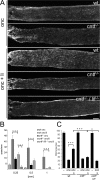Neuroprotective and axon growth-promoting effects following inflammatory stimulation on mature retinal ganglion cells in mice depend on ciliary neurotrophic factor and leukemia inhibitory factor
- PMID: 19906980
- PMCID: PMC6665071
- DOI: 10.1523/JNEUROSCI.2770-09.2009
Neuroprotective and axon growth-promoting effects following inflammatory stimulation on mature retinal ganglion cells in mice depend on ciliary neurotrophic factor and leukemia inhibitory factor
Abstract
After optic nerve injury retinal ganglion cells (RGCs) normally fail to regenerate axons in the optic nerve and undergo apoptosis. However, lens injury (LI) or intravitreal application of zymosan switch RGCs into an active regenerative state, enabling these neurons to survive axotomy and to regenerate axons into the injured optic nerve. Several factors have been proposed to mediate the beneficial effects of LI. Here, we investigated the contribution of glial-derived ciliary neurotrophic factor (CNTF) to LI-mediated regeneration and neuroprotection using wild-type and CNTF-deficient mice. In wild-type mice, CNTF expression was strongly upregulated in retinal astrocytes, the JAK/STAT3 pathway was activated in RGCs, and RGCs were transformed into an active regenerative state after LI. Interestingly, retinal LIF expression was correlated with CNTF expression after LI. In CNTF-deficient mice, the neuroprotective and axon growth-promoting effects of LI were significantly reduced compared with wild-type animals, despite an observed compensatory upregulation of LIF expression in CNTF-deficient mice. The positive effects of LI and also zymosan were completely abolished in CNTF/LIF double knock-out mice, whereas LI-induced glial and macrophage activation was not compromised. In culture CNTF and LIF markedly stimulated neurite outgrowth of mature RGCs. These data confirm a key role for CNTF in directly mediating the neuroprotective and axon regenerative effects of inflammatory stimulation in the eye and identify LIF as an additional contributing factor.
Figures




Similar articles
-
Astrocyte-derived CNTF switches mature RGCs to a regenerative state following inflammatory stimulation.Brain. 2007 Dec;130(Pt 12):3308-20. doi: 10.1093/brain/awm257. Epub 2007 Oct 30. Brain. 2007. PMID: 17971355
-
Neuronal STAT3 activation is essential for CNTF- and inflammatory stimulation-induced CNS axon regeneration.Cell Death Dis. 2013 Sep 19;4(9):e805. doi: 10.1038/cddis.2013.310. Cell Death Dis. 2013. PMID: 24052073 Free PMC article.
-
Interleukin-6 contributes to CNS axon regeneration upon inflammatory stimulation.Cell Death Dis. 2013 Apr 25;4(4):e609. doi: 10.1038/cddis.2013.126. Cell Death Dis. 2013. PMID: 23618907 Free PMC article.
-
Promoting optic nerve regeneration.Prog Retin Eye Res. 2012 Nov;31(6):688-701. doi: 10.1016/j.preteyeres.2012.06.005. Epub 2012 Jul 7. Prog Retin Eye Res. 2012. PMID: 22781340 Review.
-
Stimulating axonal regeneration of mature retinal ganglion cells and overcoming inhibitory signaling.Cell Tissue Res. 2012 Jul;349(1):79-85. doi: 10.1007/s00441-011-1302-7. Cell Tissue Res. 2012. PMID: 22293973 Review.
Cited by
-
Histone Deacetylases Regulation by δ-Opioids in Human Optic Nerve Head Astrocytes.Invest Ophthalmol Vis Sci. 2020 Sep 1;61(11):17. doi: 10.1167/iovs.61.11.17. Invest Ophthalmol Vis Sci. 2020. PMID: 32915982 Free PMC article.
-
CXCR4/CXCL12-mediated entrapment of axons at the injury site compromises optic nerve regeneration.Proc Natl Acad Sci U S A. 2021 May 25;118(21):e2016409118. doi: 10.1073/pnas.2016409118. Proc Natl Acad Sci U S A. 2021. PMID: 34011605 Free PMC article.
-
The Conditioning Lesion Response in Dorsal Root Ganglion Neurons Is Inhibited in Oncomodulin Knock-Out Mice.eNeuro. 2022 Feb 24;9(1):ENEURO.0477-21.2022. doi: 10.1523/ENEURO.0477-21.2022. Print 2022 Jan-Feb. eNeuro. 2022. PMID: 35131866 Free PMC article.
-
Pluripotent Stem Cell-Based Approaches to Explore and Treat Optic Neuropathies.Front Neurosci. 2018 Sep 20;12:651. doi: 10.3389/fnins.2018.00651. eCollection 2018. Front Neurosci. 2018. PMID: 30294255 Free PMC article. Review.
-
Optic nerve regeneration in the mouse is a complex trait modulated by genetic background.Mol Vis. 2018 Feb 15;24:174-186. eCollection 2018. Mol Vis. 2018. PMID: 29463955 Free PMC article.
References
-
- Banner LR, Moayeri NN, Patterson PH. Leukemia inhibitory factor is expressed in astrocytes following cortical brain injury. Exp Neurol. 1997;147:1–9. - PubMed
-
- Benowitz LI, Yin Y. Combinatorial treatments for promoting axon regeneration in the CNS: strategies for overcoming inhibitory signals and activating neurons' intrinsic growth state. Dev Neurobiol. 2007;67:1148–1165. - PubMed
-
- Berry M, Carlile J, Hunter A. Peripheral nerve explants grafted into the vitreous body of the eye promote the regeneration of retinal ganglion cell axons severed in the optic nerve. J Neurocytol. 1996;25:147–170. - PubMed
Publication types
MeSH terms
Substances
LinkOut - more resources
Full Text Sources
Other Literature Sources
Molecular Biology Databases
Miscellaneous
